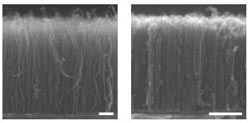Densest array of carbon nanotubes grown to date

Scanning electron microscope images are of CNT forests with low and high density.<br><br>Credit: Hisashi Sugime/U.Cambridge<br>
Carbon nanotubes' outstanding mechanical, electrical and thermal properties make them an alluring material to electronics manufacturers. However, until recently scientists believed that growing the high density of tiny graphene cylinders needed for many microelectronics applications would be difficult.
Now a team from Cambridge University in England has devised a simple technique to increase the density of nanotube forests grown on conductive supports about five times over previous methods. The high density nanotubes might one day replace some metal electronic components, leading to faster devices. The researchers report their finding in the journal Applied Physics Letters, which is produced by AIP Publishing.
“The high density aspect is often overlooked in many carbon nanotube growth processes, and is an unusual feature of our approach,” says John Robertson, a professor in the electronic devices and materials group in the department of engineering at Cambridge. High-density forests are necessary for certain applications of carbon nanotubes, like electronic interconnects and thermal interface materials, he says.
Robertson and his colleagues grew carbon nanotubes on a conductive copper surface that was coated with co-catalysts cobalt and molybdenum. In a novel approach, the researchers grew at lower temperature than is typical which is applicable in the semiconductor industry. When the interaction of metals was analyzed by X-ray photoelectron spectroscopy, it revealed the creation of a more supportive substrate for the forests to root in. The subsequent nanotube growth exhibited the highest mass density reported so far.
“In microelectronics, this approach to growing high-density carbon nanotube forests on conductors can potentially replace and outperform the current copper-based interconnects in a future generation of devices,” says Cambridge researcher Hisashi Sugime. In the future, more robust carbon nanotube forests may also help improve thermal interface materials, battery electrodes, and supercapacitors.
The article, “Low temperature growth of ultra-high mass density carbon nanotube forests on conductive supports” by Hisashi Sugime, Santiago Esconjauregui, Junwei Yang, Lorenzo D'arsié, Rachel A. Oliver, Sunil Bhardwaj, Cinzia Cepek and John Robertson appears in the journal Applied Physics Letters. See: http://dx.doi.org/10.1063/1.4818619
ABOUT THE JOURNAL
Applied Physics Letters features concise, rapid reports on significant new findings in applied physics. The journal covers new experimental and theoretical research on applications of physics phenomena related to all branches of science, engineering, and modern technology. See: http://apl.aip.org
Media Contact
More Information:
http://www.aip.orgAll latest news from the category: Physics and Astronomy
This area deals with the fundamental laws and building blocks of nature and how they interact, the properties and the behavior of matter, and research into space and time and their structures.
innovations-report provides in-depth reports and articles on subjects such as astrophysics, laser technologies, nuclear, quantum, particle and solid-state physics, nanotechnologies, planetary research and findings (Mars, Venus) and developments related to the Hubble Telescope.
Newest articles

Bringing bio-inspired robots to life
Nebraska researcher Eric Markvicka gets NSF CAREER Award to pursue manufacture of novel materials for soft robotics and stretchable electronics. Engineers are increasingly eager to develop robots that mimic the…

Bella moths use poison to attract mates
Scientists are closer to finding out how. Pyrrolizidine alkaloids are as bitter and toxic as they are hard to pronounce. They’re produced by several different types of plants and are…

AI tool creates ‘synthetic’ images of cells
…for enhanced microscopy analysis. Observing individual cells through microscopes can reveal a range of important cell biological phenomena that frequently play a role in human diseases, but the process of…





















